 If you’re a regular Insider’s Edge reader you’ll know that I highly recommend WordPress for anyone who wants to set up a website for business or fun.
If you’re a regular Insider’s Edge reader you’ll know that I highly recommend WordPress for anyone who wants to set up a website for business or fun.
You can use to create news sites, hobby sites, portfolios, online journals, sales pages, photo galleries – virtually anything you can think of.
It’s free, incredibly user friendly and powerful. Some of the most successful and well-respected websites you’ll come across use WordPress.
(If you’re interested you can see my review of some of the other major website/blogging platforms – Blogger, Tumblr, WordPress, Joomla here).
In this article I’m going to show you the fastest and simplest way I’ve come across to set up a WordPress site. This technique takes just 7 clicks. You don’t need any technical skills whatsoever and if you’ve got everything on the checklist below you can be up and running in approximately 3 minutes or less.
Let’s get the boring bit out of the way first…
Here’s what you need:
1. A working email address
2. An Internet connection
3. A web hosting package. Specifically one that offers a tool called ‘cPanel’
Let me explain that third one in more detail.
To run any self-hosted website you need your own domain and hosting package. By domain I mean your own website address e.g. www.yournamehere.com and by hosting package I mean a provider who’ll ‘host’ the information for you online so that the world can see it.
If you’re wondering what on earth cPanel is (as well you might!) it’s a simple tool that many web hosting providers offer. It makes life for non-technical people infinitely easier. I mean that, cPanel has a wide range of uses, not just WordPress installations.
If you’re not a technical person, trying to install WordPress the manual way can have you pulling your hair out and take forever. Using cPanel you can have a website up and running in under 5 minutes.
Not sure which hosting providers offer cPanel?
I will be doing a review of some of the major hosting providers on offer but if you want to cut to the chase, by far and away the best hosting provider I’ve come across or used to date is a UK based company called JustHostMe who I’ve mentioned once before.
I now host the majority of my websites with these guys and am slowing migrating my others their way too. Why? Because they offer excellent support. On more than one occasion I’ve contacted them at bizarre night owl times (11pm… 1am…) and received help within minutes. They also offer some of the lowest priced hosting packages I’ve come across which is why they get an unhesitant 5 stars from me.
Am I gushing? I suppose I am a bit. It’s just that I’ve spent years battling with incompetent hosting providers who charge too much and have moody and unhelpful staff – these guys have given me a renewed faith in the murky world of tech.
You can get your domain name and set up a hosting package with them here (they offer a risk-free trial period). Another excellent UK based web hosting provider that I keep hearing consistently good reports about are Web Hosting UK. The technique for installing WordPress is slightly different with these guys but you should be able to follow the same method using the instructions below.
Now as I said you can use this guide to set up WordPress using virtually any hosting provider that offers cPanel, have a look around on Google. These are just my personal recommendations based on the 10 – 15 (both US and UK based) web hosting providers I’ve used in the past (including 123 reg, 1&1 and hostgator, to name a few…)
What can I do if my hosting provider doesn’t have cPanel,
are there any alternatives?Yes. If you already have hosting with a different hosting provider who doesn’t have cPanel it’s worth checking with them to see if they have their own automated WordPress installer. The other alternative is to brave a manual install. If you want to go this route I highly recommend using this guide. It’s written by a top WordPress expert and takes you through everything in simple step-by-step terms. My brother-in-law who is positively terrified of computers, websites and anything techie managed to set up a website successfully in an hour or two with it. It also gives you great advice for customising your site, and monetising it.
Just to be clear the remainder of this guide is for people who have a hosting account which does provide cPanel.
Right, hopefully you’re with me so far. If you’ve got a domain name, your hosting and your cPanel login details to hand you’re all set! In just a few minutes from now you should have your very own WordPress website up and running.
Let’s get started:
Step 1 – Login to your cPanel
The first thing you need to do is login to your personal cPanel. There should be a link to it in one of the welcome emails from your hosting provider but there’s another simple way to access it and that is to simply type your domain name into your browser followed by: ‘/cpanel’.
So for example:
http://www.yourdomain.co.uk/cpanel
Hit enter or return to load the page and the next screen you see should look something like this:
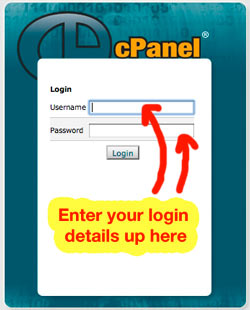
Now enter your user name and password in the boxes provided and click ‘Login’.
That’s click 1 out of the way.
Step 2 – Look for a little smiley face icon called ‘Fantastico’ or ‘Softaculous’
The screen you can see now will look something like this:
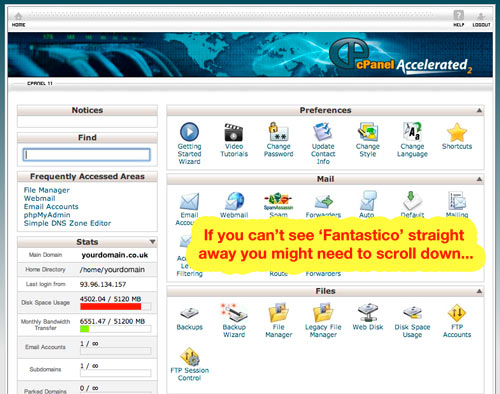
Don’t worry if the icons are in slightly different places on your screen. You’re looking for ‘Fantastico’. I know, I know ‘Fantastico’ sounds like a pervy Italian waiter but it’s considerably more useful. It’s usually located towards the bottom so you might need to scroll down as I did on mine.
Here’s what it looks like:

Click on the icon once.
Please note: Some web hosting providers (such as Web Hosting UK) something very similar to Fantastico called ‘Softaculous’ if yours does click on that. The icon will like like this instead: 
That’s click number 2 done.
Step 3 – Choose WordPress from the left hand menu
The screen you can see now will look something like this:

Locate WordPress on the left hand column and click on it (that’s click 3).
Please note: Softaculous users click the giant WordPress logo here.
Now you should see the following, or something similar:
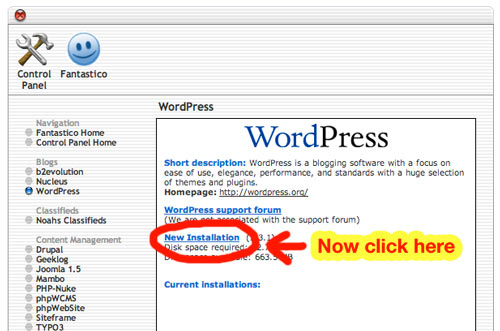
Click on the words: ‘New Installation’ which I’ve circled in red.
Click 4 done.
Step 4 – Enter your details in the boxes provided
This next bit might look scary but don’t worry, I’ll walk you through it. It only takes a second.
Here’s what you’ll see:
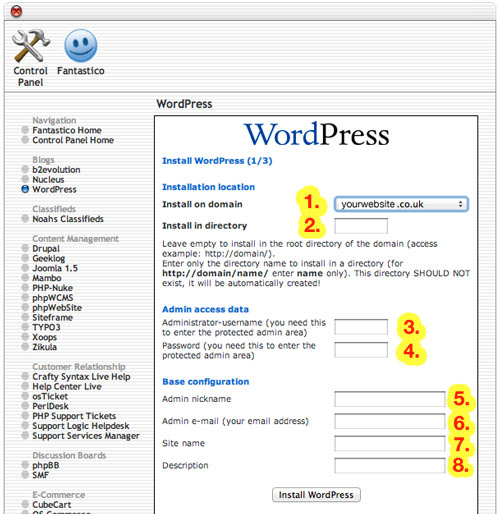
The ‘Install on domain’ (no. 1) drop down menu on the right which says ‘yourwebsite.co.uk’ is the domain you are installing WordPress on. If your domain is ‘Ilovecats.co.uk’ it’ll say ‘Ilovecats.co.uk’.
If you have several domains you’ll need to pick the relevant one from the drop down menu.
The next area (no. 2): ‘Install on directory’ is where on that domain you want it installed.
If you want your WordPress homepage to be domain name (for example ‘Ilovecats.co.uk’) then just leave this one blank. If you want it to be on a subpage – or after a forward slash (for example Ilovecats.co.uk/blog) then enter the relevant word here. In this case it would be ‘blog’ but you could choose anything. In most cases you’ll want to leave this section blank though.
The two ‘Admin access data’ fields (no. 2 and 3) are just your login details to get you into your WordPress site to add pages and posts/entries once it has been installed. You can put anything here but don’t make it too obvious, you don’t want to make it easy for hackers to guess. I would strongly advise against using the username ‘admin’ here. I’d also suggest putting some numbers in your password.
Nearly there…
Admin nickname (no.4) – This is the name that will display next to your articles (so for example I would choose ‘Tom Wake’).
Admin email (no.5) – This is where you need to put your primary email address (the one you use most often). If you forget your password this is where it’ll be resent.
Site name (no.6) – What’s the name of your site? For example this site is ‘Insider’s Edge’. Yours will be different. You can change this later should you need to.
Description (no.7) – This is your tagline or a brief summary of what your site is about. So in our ‘I love cats’ example you might have something like ‘Your one stop resource for all things cat related’. Bad example but you get the idea. Again you can change this later should you need to.
Now you are ready to click ‘Install WordPress’ at the bottom.
That’s your 5th click done!
Step 5 – Click ‘Finish’ and then email the details to yourself
You’ve done the ‘hard’ part. Now it’s just a case of clicking through the next couple of screens…
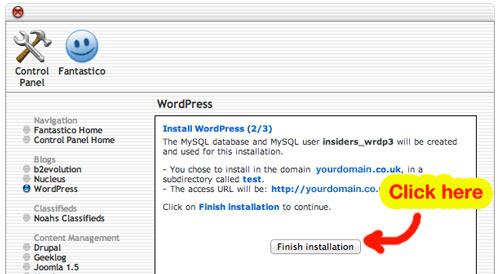
After clicking ‘Finish Installation’ (click 6) you’ll see the following:

At this point your WordPress site is installed and online. You have the option to send the details of the installation to an email address of your choice (click 7). This is worth doing for reference purposes.
That’s it! You’ve now got your website online and ready to edit
Your website is now on display and you can find it by entering the url or domain you installed it to (e.g. www.yourdomain.co.uk).
Obviously you haven’t put any articles or content on there yet so it’ll look pretty sparse. It’ll probably look something like this:
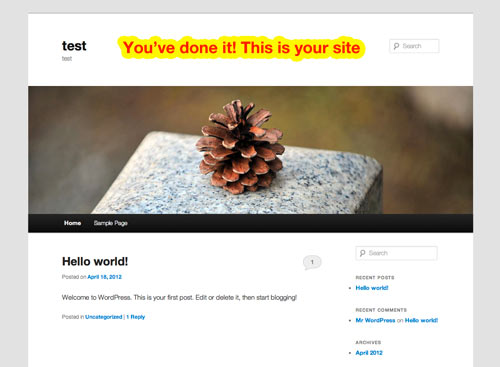
At this point you’ll want to start adding some content. In order to do this you need to log in to what’s known as the ‘back end’. This can be accessed at any time and from anywhere by typing in your website address followed by the following: ‘/wp-admin’.
So for example…
www.yourdomain.co.uk/wp-admin
You’ll be asked for the login details you entered in step 4. Enter these and you’ll be taken to where the magic happens. From here you can add articles (or posts) and pages. You’ll see all the various options on the left hand side so have a play around.
I’ll be adding more tutorials showing you how to edit your site in upcoming articles so if you’re not already, make sure you’re subscribed to the free Insider’s Edge eZine by signing up below.
Please leave a comment below if you found this tutorial helpful.

22 responses to “How to set up a WordPress website in 7 clicks”
I love your writing style, Tom, and this particular “tutorial” is so crisp, clear and concise.
Thank you
Thank you Colin!
Interesting post, Tom. I think your explanation of setting up a self-hosted WordPress site is very clear, but I would have thought it might be worth mentioning the Free version of WordPress also – at WordPress.com. Either way, now that you’ve covered the setting up process so well, may I suggest you do a follow-up sometime – covering the myriad of (often confusing) WordPress paid, and free, themes, widgets, etc., needed to build a good-looking and effective Website/Blog..? As you know, this is a bit of a minefield, and finding a Theme that is infinitely adaptable and flexible takes some doing, so your advice would be very beneficial at that stage. For our Writer’s ‘Write2Profit’ Website, when adding a Blog to it, we got so frustrated with trying to get what we wanted with WordPress, that we went with another – much more adaptable (design-wise)- system altogether in the end. WordPress has it’s good points, but needs to go a long way yet in being more flexible and user-focused, and far less confusing in describing its features. There are, I believe some new Blogging systems being built right now, which soon (hopefully) will rival WordPress…
Hi Andy, good point. I think I’ve mentioned the non hosted version of WP on a previous article but perhaps it’s worth touching on here as well. For anyone who’s interested here’s the link for this. It’s a really good way to get familiar with the platform. With that said I strongly believe that self-hosted is the way to go as it ensures you get all of the juice from your web traffic and gives you much more control.
I’ll definitely be doing a follow up series with this which will cover installing themes, making edits, choosing widgets, plugins and the whole shebang. I hope you find it useful.
Thanks Tom. I’ll look forward to seeing your follow up series soon. (You might even convert me back to WordPress again, too).
Thanks again for reply. Keep up the good work!
Excellent Tom. I almost paid £37 for something similar.
A nice easy to follow article Tom that should encourage a lot of your readers to take the plunge and get on-line.
I look forward to the follow-on articles.
Best Wishes,
Fred.
Thanks David and Fred!
Hi Tom – I followed this using Web Hosting UK. It is not the same process, but roughly similar. Managed to work it out using not Fantastico, but Spectaculus to help me set up. Now I just need to work out what a SQL database is for!! Thanks Agnes
Hi Agnes, thanks for letting me know. They must have just brought that change in (I think it’s called Softaculous, though Spectaculous has a better ring to it!) I’ll make a note of it above.
It should be virtually the same process but would it help if I posted some screenshots – or did you work it out?
By the way you shouldn’t need to enter any database settings (i.e. you can leave them as they have them filled in during the installation process).
[…] How to set up a WordPress website in 7 clicks […]
[…] How to set up a WordPress site in 7 clicks […]
[…] If you’re still not sure what I’m rambling on about you can get a full breakdown of the difference between plugins and widgets and posts and pages from my jargon buster article here. Not got a WordPress website? You can find out how to set one up in 7 easy steps here. […]
[…] email newsletter, ideally. If this interests you – and you want a website for free, check out How to set up a WordPress website in 7 clicks And finally today, a warning…. Why you should avoid the Home Website Centre One of […]
[…] you installed WordPress on these websites (which is free) they would be infinitely more powerful, customizable and […]
[…] have SIX or even SEVEN of your own websites with a reputable hosting company. If you installed WordPress on these websites (which is free) they would be infinitely more powerful, customizable and […]
[…] For a basic guide to creating a website, check this out. […]
Bro, i want to start a community website that will be talking about a particular town… Will normal web design be better or i should used blogging platform.. Please i will be very happy, if you respomds to my message urgently, thanks
Hi Azeez, I would definitely go for a blogging platform – and I would personally go for WordPress. It’ll give you much more control and scope for expansion in the long term and you can still have a traditional magazine or website look if you don’t want it to feel like a ‘blog’.
[…] Now that you’ve got a logo for your business, why not set up a website? Find out how here: How to set up a WordPress website in 7 clicks […]
[…] If you want to go the WordPress route (recommended) here’s my how to guide for setting up a WordPress site in 7 clicks. […]
[…] How to set up WordPress site in 7 clicks […]